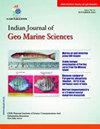海藻酸盐、壳聚糖和羧甲基纤维素三元微球对二价离子的吸附研究
IF 0.5
4区 地球科学
Q4 Earth and Planetary Sciences
引用次数: 0
摘要
采用间歇吸附法研究了海藻酸钠(AL)/壳聚糖(CS)/羧甲基纤维素(CMC)微球作为吸附剂去除水中Cu (II)、Ni (II)等二价金属离子的潜力。利用FT-IR和XRD测量方法研究了三元微珠的形成过程。以批处理方式考察了金属离子去除率与金属离子溶液pH、初始金属离子浓度、吸附剂用量和接触时间的关系。观察结果表明,去除这两种金属离子的最佳pH为5.0。实验数据与理论模型的结合表明,通过准二级(r2 > 0.9)动力学,吸附将是多层的。对铜离子(cmax = 203.69 mg/g)的去除效果优于镍离子(cmax = 194.05 mg/g)。本文章由计算机程序翻译,如有差异,请以英文原文为准。
Sorption studies of divalent ions onto ternary beads of alginate, chitosan and carboxymethyl cellulose
The potential of sodium alginate (AL)/ chitosan (CS)/ carboxymethyl cellulose (CMC) beads as an adsorbent for removing the divalent metal ions such as Cu (II) and Ni (II) ions from aqueous solution was assessed in the current work using a batch adsorption technique. FT-IR and XRD measurements were used to investigate the formation of the ternary beads. The percentage removal of metal ions was investigated in batch mode as a function of metal ion solution pH, initial metal ion concentration, adsorbent dosage, and contact time. The observed outcome shows that the best pH for removing both metal ions was reported to be 5.0. The incorporation of experimental data in theoretical modelling exhibits that the adsorption would be multilayer through pseudo-second order ( R 2 > 0.9) kinetics. The removal efficiency of ternary beads reveals that copper ions (C max = 203.69 mg/g) were removed better than nickel ions (C max = 194.05 mg/g).
求助全文
通过发布文献求助,成功后即可免费获取论文全文。
去求助
来源期刊
CiteScore
1.50
自引率
0.00%
发文量
0
审稿时长
1.7 months
期刊介绍:
Started in 1972, this multi-disciplinary journal publishes full papers and short communications. The Indian Journal of Geo-Marine Sciences, issued monthly, is devoted to the publication of communications relating to various facets of research in (i) Marine sciences including marine engineering and marine pollution; (ii) Climate change & (iii) Geosciences i.e. geology, geography and geophysics. IJMS is a multidisciplinary journal in marine sciences and geosciences. Therefore, research and review papers and book reviews of general significance to marine sciences and geosciences which are written clearly and well organized will be given preference.

 求助内容:
求助内容: 应助结果提醒方式:
应助结果提醒方式:


